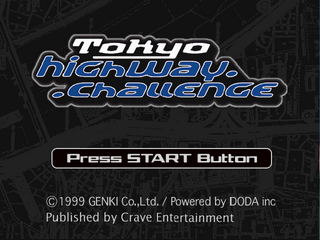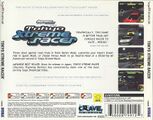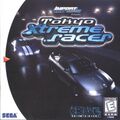Difference between revisions of "Tokyo Xtreme Racer"
From Sega Retro
| Line 137: | Line 137: | ||
'''Associate Producer''': Chris Scaglione | '''Associate Producer''': Chris Scaglione | ||
| + | |||
| + | ==Promotional Material== | ||
| + | <gallery> | ||
| + | TokyoXtremeRacer DC US PrintAdvert.jpg|US print advert | ||
| + | TokyoHighwayChallenge DC FR PrintAdvert.jpg|FR print advert | ||
| + | </gallery> | ||
==Physical Scans== | ==Physical Scans== | ||
Revision as of 14:10, 29 October 2014
| Tokyo Xtreme Racer | |||||
|---|---|---|---|---|---|
| System(s): Sega Dreamcast | |||||
| Publisher: Crave Entertainment, Genki (JP) | |||||
| Developer: Genki | |||||
| Genre: Racing | |||||
| |||||
| This article needs cleanup. This article needs to be edited to conform to a higher standard of article quality. After the article has been cleaned up, you may remove this message. For help, see the How to Edit a Page article. |
Tokyo Xtreme Racer, called Shutokō Battle (首都高バトル) in Japan and Tokyo Highway Challenge in Europe, is a 1999 racing game for the Dreamcast in Genki's popular Shutokō Battle series. The game is also one of the first mission based driving games. The player challenges other drivers on the Shuto Expressway in order to gain money to modify and enhance his or her car. The game features a wide variety of Japanese cars and tuning parts to purchase as the player progresses through rivals.
When released in Japan, Shutokō Battle was one of the best selling Dreamcast title at this time. The game is based on illegal highway racing in Tokyo's Wangan highway with custom tuned cars. A such phenomenon is growing popular in Japan since the 90's with its dedicated manga (Shutokō Battle's biggest inspiration being Wangan Midnight), anime series and video games (C1 Circuit, Wangan Trial, Naniwa Wangan Battle).
Contents
Mobile edition
2002 Vodavone Live! 2D mobile version by Genki Mobile with unlicensed Japanese cars. Game download and gaming service only available in Japan. "Time Attack" passwords from "Shutokō Battle Zero" (PlayStation 2) can be used to unlock extra cars. Day/night racing conditions are directly taken from the user's mobile real time data. Melodies from "Kaido Battle 2 Chain Reaction" were available for free download from 25/02 to 31/03 2004 to Shutokō Battle owners only. [edit] Portable edition
In 2005, a PlayStation Portable edition designed by GRP (Genki Racing Project) that included licensed Japanese cars, was being created with the working title "Shutokō Battle Zone Of Control", but it has been shortened to "Shutokō Battle" when released. Weekly Famitsu rated it 31/40, while the original Dreamcast title received 32/40. This PSP edition was licensed to Konami to be released in North America as Street Supremacy in early 2006.
Gameplay
The objective is to race every gang member on the Wangan Tokio Highway and become to top highway racer. To do this, the player starts with a Low-performance entry car and he has to challenge gang members while on a free run session on the highway. The player doesn't have an option to challenge rivals on the menu, instead, he has to be on the Highway and find a rival for itself. When a rival takes his challenge, 2 lifebars appear in the upper part of the screen, these lifebars decrease when a player is in the back (Second). If the lifebar is out, that player loses. No matter if the player won or lose, it wins money to buy parts and upgrade the car, also when winning, the gang member is recorded in a "encyclopedia" where every gang member is listed with personal info.
The unlock-upgrade system is also very basic, the player has some customization options divided in Visual and Performance. Visual upgrades let the player customize the look of his car, from bumpers to color or spoilers. The Performance part lets the player upgrade his engine, brakes, or suspension. To win these upgrades the player just has to win races in a day: A day is when you enter the Free Run mode, and then going back to the garage where all the options are, if the player decides to go back to the Free run, it will be the next day.
Campaign
Japanese famous die-cast models company, Tomica released a limited edition of Banshee's NSX in 1999. In the western release of the Dreamcast game, Banshee's controversial forehead tattooed Hindu swastika was removed.
Inspirations
- A famous car is hidden in the Japanese version, this car is Takumi Fujiwara's (from popular manga & TV series "Initial D") Fujiwara Tofu Shop "Home Delivery" Trueno. This special car is the only one with the ability to drive in the wrong way of the traffic. When doing this, a police siren is heard. The Genki Racing Project team later included the same car in Racing Battle.
- In Shutokō Battle 0, another hidden car was the red S15 Silvia that of Nobuteru Taniguchi from the D1GP series with his original livery and is sponsored by the publisher. Taniguchi, between 2004–05, drove for Bandoh Racing, who incidentally endorsed the earlier games.
- The Last Bosses, called "Devils", cars are designed according to those appearing in the 1992 manga Wangan Midnight. "Zero" drives the same large fog lights equipped black Porsche 911 Turbo (Type-964) than Tatsuya Shima, while "???" owns Wangan Midnight's main character, Akio Asakura's tuned blue Fairlady Z (Type-S30) "Devil Z".
Types & Licenses
Since it's introduction in the mid '90s, like similar games, the "Shutokō Battle" series never used licensed cars but the usual type designation such as "TYPE-86" and later "TYPE-AE86L3". Nicknames were used instead in the "Wangan Dead Heat" sidestory (e.g. "Rapid Fire" for the "Nissan Skyline GT-R R33"). These "types" are actually the real chassis code used by the Japanese makers to designate the various grades of a lineup. As the graphics quality was improving with each release, from 16-bit 2D to 3D/CG 128-bit, the featured cars were becoming more and more similar to the actual cars appearance. In a similar way, the chassis codes became longer and more precise, allowing the player to determine each grade and to use the "rename car" feature. Inevitably, the game becoming a solid best seller, the Japanese makers forced Genki to buy the license of their cars. The very first Genki licensed game was Wangan Midnight for PlayStation 2 (28.03.2002), while the first licensed "Shutokō Battle" was Shutokō Battle Online released on PC, the 9th of January 2003. Since then, every Genki racing game uses licensed makers, and ingame cars with Honda chassis codes don't appear anymore in the Shutokō Battle games (However, Honda is licensed in the Kaido Battle series).
Car List
Entry cars
Toyota
- (AE86T) Toyota Sprinter Trueno GT A'pex 3DOOR 1986
- (AE86L) Toyota Corolla Levin GT A'pex 3DOOR 1986
- (JZA80) Toyota Supra Type RZ TWIN TURBO 1997
- (JZX100) Toyota Chaser Tourer-V TURBO 1998
- (SW20) Toyota MR2 GT1997
- (XE10) Toyota Altezza RS200 "Z EDITION" 1998
Nissan
- (RPS13) Nissan Silvia 180SX type X 1994
- (S13) Nissan SILVIA K's 2000cc 1988
- (S14) Nissan Silvia K's AERO SE 1996
- (Z32) Nissan Fairlady Z Version S Twin Turbo 2 seater 1998
- (R32) Nissan Skyline GT-R V-spec II 1994
- (R33) Nissan Skyline GT-R V-spec 1997
- (Y33C/Y33G) Nissan CEDRIC BROUGHAM VIP/Nissan GLORIA Gran Turismo ULTIMA 1997
Mazda
- (FC) Mazda SAVANNA RX-7 ∞-III 1989
- (FD) Mazda RX-7 Type RS 1995
- (MX5) Mazda Miata Eunos roadster 1985
- (MX5) Mazda Miata MX5 2000
Mitsubishi
- (CE9A) Mitsubishi Lancer GSR Evolution III 1995
- (CP9A) Mitsubishi Lancer GSR Evolution VI 1999
Subaru
- (GC8) Subaru Impreza 2DOOR WRX type R STi Version V 1997
Honda
- (DC2) Honda Integra type R 3DOOR spec'98 1998
- (EK9) Honda Civic type R spec'98 1998
- (NA2) Honda NSX type S Zero 1997
Extra cars
Honda
- (AP1) S2000 1999
Nissan
- (S15) Silvia Spec-R 1999
- (R34) Skyline GT-R V-spec 2000
- (S30) Fairlady Z 1978 (Wangan Midnight tuned version)
Porsche
- (964) 911 Turbo 1989 (Wangan Midnight tuned version)
Special cars
Four Devas
- (FDD) Midnight Cinderella's RX-7 1999 (flame version)
- (NA2D) Banshee's NSX 1999 (flame version)
- Banshee's only available in the Japanese edition
Four Devils
- (JZA80D) Exhaust Eve's Supra 1999 (racing stripes version)
- (R34D) Raven Blood's Skyline 1999 (red tuned version)
Initial D
- (AE86TD) Takumi Fujiwara's Trueno 2000 (Fujiwara Tofu Shop "Home Delivery" version)
- only available in the Japanese edition
Mitsubishi
- (GFLF) Eclipse GS-T 1999
- (GFLS) Eclipse Spyder GT 1999
- not available in the Japanese edition
Sequels
In 2000, the first sequel, titled Tokyo Xtreme Racer 2, was released for Sega Dreamcast in Japan and North America. A version of the game for the PAL region was released as Tokyo Highway Challenge 2.
In 2001, the second sequel, titled Tokyo Xtreme Racer: Zero, was released for PlayStation 2 in Japan and North America. This was originally intended to be released for Dreamcast, but those plans were scrapped.
In 2003, the third sequel, titled Tokyo Xtreme Racer: 3, was released for PlayStation 2. Kaido Battle was also released that year in Japan and focused on touge racing and drifting.
Shutokō Battle was released for Xbox 360 in Japan on July 27, 2006. It was later released under the title, Import Tuner Challenge, to North America and Europe on September 26, 2006.
On February 28, 2006, a new installment of the series was released for the PSP, marketed as Street Supremacy in North America. Later, in April of that year, North America saw the release of Tokyo Xtreme Racer: Drift, a localized version of the 2003 title, Kaido Battle, previously only available in Japan.
The last sequel, entitled Tokyo Xtreme Racer: Drift 2 (the North American release of Kaido: Touge no Densetsu), was released on April 17, 2007. Kaido Battle 2: Chain Reaction (2004, released in Europe as Kaido Racer) was skipped in North America.
Credits
Executive Producer: Mike Arkin
Associate Producer: Chris Scaglione
Promotional Material
- TokyoXtremeRacer DC US PrintAdvert.jpg
US print advert
- TokyoHighwayChallenge DC FR PrintAdvert.jpg
FR print advert
Physical Scans
| 60 | |
|---|---|
| Based on 31 reviews | |
- ↑ File:ROD_DC_01.pdf, page 39
- ↑ Arcade, "October 1999" (UK; 1999-08-23), page 94
- ↑ Consoles +, "Août 1999" (FR; 1999-0x-xx), page 96
- ↑ Dreamcast Monthly, "November 1999" (UK; 1999-11-18), page 71
- ↑ Dreamcast: Le Magazine Officiel, "Octobre/Novembre 1999" (FR; 1999-xx-xx), page 101
- ↑ Dreamcast: Das Offizielle Magazin, "November 1999" (DE; 1999-11-11), page 52
- ↑ Dreamcast Magazine, "1999-21 (1999-07-02)" (JP; 1999-06-18), page 17
- ↑ Dreamcast Magazine, "No. 3" (UK; 1999-11-25), page 64
- ↑ Dorimaga, "2002-18 (2002-10-11)" (JP; 2002-09-27), page 34
- ↑ Dreamzone, "Decembre 1999" (FR; 1999-11-16), page 110
- ↑ Edge, "September 1999" (UK; 1999-08-09), page 87
- ↑ Electronic Gaming Monthly, "October 1999" (US; 1999-09-07), page 220
- ↑ Entsiklopediya igr dlya Dreamcast, "Izdaniye chetvertoye, dopolnennoye" (RU; 2002-xx-xx), page 271
- ↑ Famitsu, "1999-07-02" (JP; 1999-06-18), page 31
- ↑ Fun Generation, "11/99" (DE; 1999-10-13), page 86
- ↑ GamePro, "October 1999" (US; 1999-xx-xx), page 149
- ↑ GamesMaster, "Christmas 1999" (UK; 1999-11-29), page 68
- ↑ Gen 4 Consoles, "Novembre 99" (FR; 1999-xx-xx), page 132
- ↑ Game Informer, "October 1999" (US; 1999-xx-xx), page 83
- ↑ Gamers' Republic, "September 1999" (US; 1999-08-10), page 28
- ↑ MAN!AC, "11/99" (DE; 1999-10-06), page 92
- ↑ Neo Plus, "Grudzień 1999" (PL; 1999-xx-xx), page 34
- ↑ Next Generation, "September 1999" (US; 1999-08-17), page 86
- ↑ neXt Level, "September 1999" (DE; 1999-08-06), page 25
- ↑ neXt Level, "November 1999" (DE; 1999-10-08), page 42
- ↑ Official Dreamcast Magazine, "November 1999" (UK; 1999-09-30), page 95
- ↑ Official Dreamcast Magazine, "November 1999" (US; 1999-10-05), page 113
- ↑ Player One, "Novembre 1999" (FR; 1999-xx-xx), page 124
- ↑ Play, "Listopad 2001" (PL; 2001-xx-xx), page 44
- ↑ Revista Oficial Dreamcast, "Enero 2000" (ES; 1999-12-20), page 39
- ↑ Sega Magazin, "September 1999" (DE; 1999-08-04), page 14
- ↑ Video Games, "10/99 It's Dreamcast Time supplement" (DE; 1999-09-22), page 11
- Pages with broken file links
- No players field
- Old content rating field
- All games
- Cleanup
- Old-style rating (arcade)
- Rating without PDF source
- Old-style rating (dcmonthly)
- Old-style rating (dmuk)
- Old-style rating (edge)
- Old-style rating (nextlevel)
- Rating without source
- Old-style rating (playerone)
- Old-style rating (rod)
- Use magref
- Old-style rating (videogames)
- Update ratings template
- 7 old ratings








